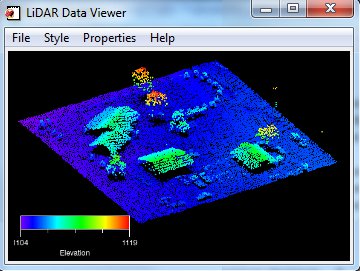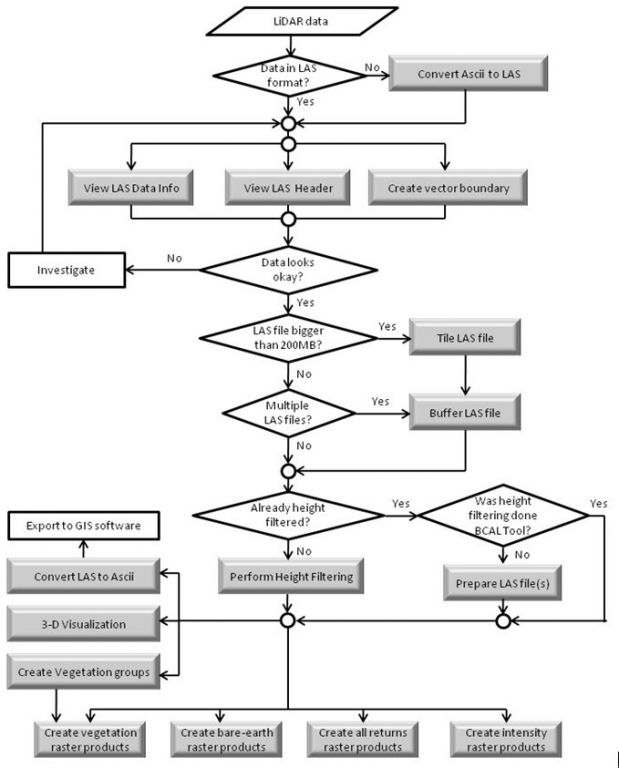博文
Lidar Tools for ENVI
|||
Lidar Tools for ENVI
ENVI4.8包含了一个简易版的Lidar Tools,这个Bcal Lidar Tools扩展补丁的处理功能更加丰富。


模块功能列表
|
LAS File Utilities |
Process/Manipulate LAS files |
|
- Get LAS Header Info |
Displays header and projection information for an LAS file |
|
- Get LAS Data Info |
Displays descriptive data statistics for LAS file(s) |
|
- Add Projection to LAS File(s) |
Adds embedded projection information to LAS files |
|
- Reproject LAS File(s) |
Converts existing LAS files into a new map projection |
|
- Convert Ascii Data to LAS |
Converts text point data into LAS format lidar files |
|
- Convert LAS Data to Ascii/Shapefile |
Converts LAS format lidar files into delimited text or ESRI Shapefile point data |
|
- Create Boundary EVF/SHP/KML |
Creates an vector file (EVF, shape or KML) that shows the boundaries of the data |
|
- Buffer LAS Files |
Geographically buffers the data using neighboring files |
|
- Tile LAS File(s) |
Divides one or more files into multiple tiles |
|
- Decimate LAS File(s) |
Decimates the points the data file |
|
- Subset LAS File(s) |
Subset LAS files by coordinates or image/ROI |
|
- - Subset via Coordinates |
Subsets data files according to user coordinates |
|
- - Subset via Image/ROI |
Subsets data files using a reference image and/or regions of interest |
|
- Export LAS File(s) |
Export LiDAR returns by return number, number of returns, classes, elevation, intensity, and scan angle |
|
- Assign RGB Channel Data |
Assigns RGB channel data from multi-band images, elevation color, or vegetation height color, to LAS 1.2 files |
|
- Extract Flight Lines |
Extract flight lines from LAS file(s) using GPS time information |
|
Perform Height Filtering |
Performs vegetation filtering on the data |
|
Create Bare-earth DEM |
Creates bare-earth digital terrain model from height-filtered LAS file(s) |
|
Create Raster Products |
Create various topographic, intensity and vegetation raster products |
|
- Create Topographic Products (Bare-earth) |
Creates various raster topographic bare-earth products |
|
- Create Topographic Products (All returns) |
Creates various raster topographic products from all point data |
|
- Create Vegetation Products |
Creates various raster vegetation products |
|
- Create Intensity Products |
Creates various raster intensity products |
|
- Prepare LAS file(s) |
Add vegetation height information to the LAS file(s) from existing bare-earth digital terrain model |
|
Rasterize Lidar Data (Legacy) |
Converts raw point data into various raster products |
|
Create Vegetation Height Groups |
Separate input LAS file into user-specified vegetation height groups |
|
Create Elevation Profile(s) |
Creates one or more elevation profiles along a user-defined transect |
|
3D Lidar Viewer |
An interactive viewer for displaying lidar point data |
This page is a basic guideline to processing LiDAR data using the BCAL LiDAR Tools software package for ENVI. More detailed information on the individual steps can be found on the information pages for the respective tools.
Step 1: Convert your data to the .las format (if necessary)The BCAL LiDAR Tools package requires that all data be in the .las data format. If your data are not in this format, you will need to convert them before any processing can take place. The BCAL LiDAR Tools package contains a conversion tool for converting your data from ascii to las.
Step 2: Tile your data (if necessary)In order to accomplish many of the functions in the BCAL LiDAR Tools package, the software must be able to read the individual files into the computer's memory. If the files are too large (or if the computer's memory is limited), they can be broken into smaller files using the tiling feature. Alternatively, large files may also be subset or decimated.
Step 3: Explore your dataUse the file info tool to explore your data files. Things to look for include projection information (or lack thereof), point density, number of returns available, and the spatial extents of the data. Also of use is the boundary tool, with which you can display the geographic footprints of the individual files.
Step 4: Buffer your data (optional)When filtering and/or rasterizing multiple files at once (for a single project), the software often has problems at the seams between the data tiles. These problems can be overcome by buffering the data, which creates areas of overlap between the files. The buffer distance (and thus distance of overlap) should be several times the value of the canopy spacing (filtering) or pixel size (rasterizing).
Step 5: Filter your dataIf you are interested in calculating the heights of vegetation in your data or determining bare ground elevations, use the height filtering tool.
Step 6: Rasterize your dataUse the raster tool to create various raster products from your data. Remember that the raster products related to vegetation and/or bare ground cannot be created unless the data have been filtered first.
流程图 
下载链接:http://bcal-lidar-tools.googlecode.com/files/LiDARTools-1.2.0.zip
安装方法:
将压缩包内的sav文件copy到ENVI的save_add目录下,重启ENVI即可。
https://blog.sciencenet.cn/blog-344887-428213.html
上一篇:【思考】最近热门的药家鑫事件
下一篇:idl图像显示程序(直接图形法与对象图形法混合显示)